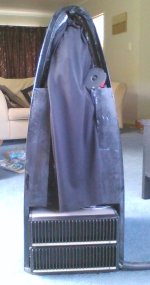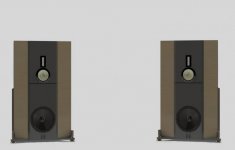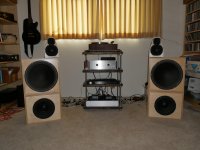Thank you.
The back don't look nearly so smooth, being hidden away.
And there's not much to see, because it's covered with a drape cloth.
The amplifiers are stacked in the bottom of the back.
The 'wing' bits on the inside sides serve 3 purposes; -
structural reinforcement, reduce the radiating area to approx that of the bass cones, and increasing the distance between front and back for bass.
The rear tweeter fires at an angle to give a slight boost to the HF energy in the room, and avoid direct reflections.
The back don't look nearly so smooth, being hidden away.
And there's not much to see, because it's covered with a drape cloth.
The amplifiers are stacked in the bottom of the back.
The 'wing' bits on the inside sides serve 3 purposes; -
structural reinforcement, reduce the radiating area to approx that of the bass cones, and increasing the distance between front and back for bass.
The rear tweeter fires at an angle to give a slight boost to the HF energy in the room, and avoid direct reflections.
Attachments
Thank you.
The back don't look nearly so smooth, being hidden away.
And there's not much to see, because it's covered with a drape cloth.
The amplifiers are stacked in the bottom of the back.
The 'wing' bits on the inside sides serve 3 purposes; -
structural reinforcement, reduce the radiating area to approx that of the bass cones, and increasing the distance between front and back for bass.
The rear tweeter fires at an angle to give a slight boost to the HF energy in the room, and avoid direct reflections.
may I ask regarding the theory/idea of "back HF" units? (tweeter etc)
thanks
Hi,
It improves the spectral balance of sound reflected within the room to make it more neutral. Reflected sound has at least as much energy as the sound coming direct from your speakers.
It's a well proven thing, with many high end speakers using them.
Quite a lot on the internet, and several threads on this forum mention them.
https://www.diyaudio.com/forums/multi-way/222708-benefits-rear-firing-tweeters.htm
ORION++
It improves the spectral balance of sound reflected within the room to make it more neutral. Reflected sound has at least as much energy as the sound coming direct from your speakers.
It's a well proven thing, with many high end speakers using them.
Quite a lot on the internet, and several threads on this forum mention them.
https://www.diyaudio.com/forums/multi-way/222708-benefits-rear-firing-tweeters.htm
ORION++
OK, I'll play. Here's my current, evolving, 3/4 OB den music system. The room is small for OB speakers, but it's too small for much of anything to work optimally. This was mostly built from drivers I already owned and re-used from other builds. Total driver cost was under $100/channel.
From the top:
TC9FD18-08, 3000 Hz & up
Peerless SDS-860656, 700 - 3000 Hz
Jamo 20388 (PE buyout from several years back), 5" deep u-frame, 150 - 700 Hz
NHT 1-11-083-2 woofer (from NHT liquidation, I think these were a raffle prize at an early Burning Amp), ~30 to 150 Hz, small sealed boxes with a gentle Linkwitz transform to reduce the system Q from .9 to .56 and slightly extend the response.
Baltic Birch cabinetry with clear poly.
MiniDSP 4x10HD, using S. Harsch topology (BW4 lowpass, 2nd order Bessel highpass acoustic slopes, upper driver delayed 1/2 wavelength @ crossover frequency + physical offset compensation) for all three transitions.
4 channel Modulus 86 amp for the upper drivers (sliver faceplate at the bottom of the rack).
2 stereo Breeze TPA-3116 amps running the mid-bass & woofers.
Bill
From the top:
TC9FD18-08, 3000 Hz & up
Peerless SDS-860656, 700 - 3000 Hz
Jamo 20388 (PE buyout from several years back), 5" deep u-frame, 150 - 700 Hz
NHT 1-11-083-2 woofer (from NHT liquidation, I think these were a raffle prize at an early Burning Amp), ~30 to 150 Hz, small sealed boxes with a gentle Linkwitz transform to reduce the system Q from .9 to .56 and slightly extend the response.
Baltic Birch cabinetry with clear poly.
MiniDSP 4x10HD, using S. Harsch topology (BW4 lowpass, 2nd order Bessel highpass acoustic slopes, upper driver delayed 1/2 wavelength @ crossover frequency + physical offset compensation) for all three transitions.
4 channel Modulus 86 amp for the upper drivers (sliver faceplate at the bottom of the rack).
2 stereo Breeze TPA-3116 amps running the mid-bass & woofers.
Bill
Attachments
Hi,
It improves the spectral balance of sound reflected within the room to make it more neutral. Reflected sound has at least as much energy as the sound coming direct from your speakers.
It's a well proven thing, with many high end speakers using them.
Quite a lot on the internet, and several threads on this forum mention them.
https://www.diyaudio.com/forums/multi-way/222708-benefits-rear-firing-tweeters.htm
ORION++
thanks!
I still have a basic question due to my being quite a lay person in this field. Unfortunately, even extensive searching for this answer over the internet has failed me, hence i take resort to you.
I do understand that irrespective of the quoted thermal power handling of a driver, its mechanical (excursion limited) power handling becomes relevant/dominant when used in applications where Vb is much > Vas.
Q.1: For a usual entry level 8" mid-bass driver (eg: Goldwood or GRS driver as sold by Parts-Express; where Fs=60 hz; Qts=0.9; Cms=0.4; Xmax=3 mm, Vas=25 litres), what can i take its "mechanical power handling" to be in free air (or open baffle) when fed with a signal at its Fs? I am looking toward a modest open baffle application.
Is there a formula or equation that can give such value for any mid-bass driver?
Q.2: Would this mechanical power handling be higher considering it is fed with music which is non-synthesised (i.e. only acoustic instruments used as in heavy orchestral and folk)? - [Note: i will be driving it direct and full-range.... without any crossover component, with only a high-pass for a tweeter.]
Q.3: Given the same driver above, how much increase in its mechanical power handling can i estimate if as an alternative, i mate it with a sealed enclosure with Vb 100 litres (Vas * 4)? Is there an equation that gives such a figure for a given Vb as relative to driver Cms-Qts & Vas, so that it may enable me to calculate mechanical power handling for a range of sealed enclosure sizes?
Could you please shed some light on this? It would greatly help me gain clarity into this issue. I eagerly look forward to your insight and guidance!
Thanks and regards,
Sujat
I do understand that irrespective of the quoted thermal power handling of a driver, its mechanical (excursion limited) power handling becomes relevant/dominant when used in applications where Vb is much > Vas.
Q.1: For a usual entry level 8" mid-bass driver (eg: Goldwood or GRS driver as sold by Parts-Express; where Fs=60 hz; Qts=0.9; Cms=0.4; Xmax=3 mm, Vas=25 litres), what can i take its "mechanical power handling" to be in free air (or open baffle) when fed with a signal at its Fs? I am looking toward a modest open baffle application.
Is there a formula or equation that can give such value for any mid-bass driver?
Q.2: Would this mechanical power handling be higher considering it is fed with music which is non-synthesised (i.e. only acoustic instruments used as in heavy orchestral and folk)? - [Note: i will be driving it direct and full-range.... without any crossover component, with only a high-pass for a tweeter.]
Q.3: Given the same driver above, how much increase in its mechanical power handling can i estimate if as an alternative, i mate it with a sealed enclosure with Vb 100 litres (Vas * 4)? Is there an equation that gives such a figure for a given Vb as relative to driver Cms-Qts & Vas, so that it may enable me to calculate mechanical power handling for a range of sealed enclosure sizes?
Could you please shed some light on this? It would greatly help me gain clarity into this issue. I eagerly look forward to your insight and guidance!
Thanks and regards,
Sujat
You could start here
Tolvan Data
Thank you for the link, Kjeldsen. I will go through it and take guidance.
Warm regards for a severe winter 🙂
I think it is good practice to limit the lower end of midbass drivers (high-pass) on open baffle especially with less robust drivers... it is easy to do with DSP but would be expensive with passive components.
^
there are only bass drivers, no midbass drivers, for bass duty in OB
and...line level HP is not expensive at all!
there are only bass drivers, no midbass drivers, for bass duty in OB
and...line level HP is not expensive at all!
I think it is good practice to limit the lower end of midbass drivers (high-pass) on open baffle especially with less robust drivers... it is easy to do with DSP but would be expensive with passive components.
Yes zmyrna, i totally agree. Thank you for responding.
^
there are only bass drivers, no midbass drivers, for bass duty in OB
and...line level HP is not expensive at all!
Thanks for your response, picowallspeaker. I totally agree with you!
However, i am simply trying to get an idea about the bare minimum wattage that will push it to full Xmax. That way i can get a vague idea of extrapolating the midbass driver's excursion limiting power-handling in case i need to use it in a large sealed enclosure (Vb >= 4*Vas, if you refer to my question no.3 in the original post) probably with an additional resistive pressure release vent so as to keep Qtc as low as possible.
Basically i am working toward using the 8" midbass driver very lightly loaded.
Last edited:
Sorry, I thought it was the OB thread, not simply multi-way 😱😱
I generally consider the diameter and the material, then check the Xmax.
With paper cone it is easy to flex of the cone so no particular damage, excused the off-phase emissions in some areas of the membrane 🙄
I think that the limit fixes the pistonic behavior of a speaker.
Yes
The only box I've made for a 8" consists if a folded Voigt type that I made some 22 years ago 🙄 I later added two extra volumes, the size of a cup, in the vicinity of the driver- Two because we're talking stereo .
You could wrap a 'carpet on the basket' to do that. Use the frame+ textile to form some dampening.
Yes it's referenced somewhere
it's referenced somewhere
I generally consider the diameter and the material, then check the Xmax.
With paper cone it is easy to flex of the cone so no particular damage, excused the off-phase emissions in some areas of the membrane 🙄
I think that the limit fixes the pistonic behavior of a speaker.
Yes

The only box I've made for a 8" consists if a folded Voigt type that I made some 22 years ago 🙄 I later added two extra volumes, the size of a cup, in the vicinity of the driver- Two because we're talking stereo .
You could wrap a 'carpet on the basket' to do that. Use the frame+ textile to form some dampening.
Yes
 it's referenced somewhere
it's referenced somewhereSorry, I thought it was the OB thread, not simply multi-way 😱😱
I generally consider the diameter and the material, then check the Xmax.
With paper cone it is easy to flex of the cone so no particular damage, excused the off-phase emissions in some areas of the membrane 🙄
I think that the limit fixes the pistonic behavior of a speaker.
Yes
The only box I've made for a 8" consists if a folded Voigt type that I made some 22 years ago 🙄 I later added two extra volumes, the size of a cup, in the vicinity of the driver- Two because we're talking stereo .
You could wrap a 'carpet on the basket' to do that. Use the frame+ textile to form some dampening.
Yesit's referenced somewhere
I was thinking on the lines that the Xmax as well as the Cms of the driver together might give some indication as to how many watts it would take to drive it to Xmax in free air. I am no expert, so please bear with my modest understanding. 🙂
Latest iterations of my open baffle speakers. they are now a three-way design, Scan-Speak H2606 tweeter, Coral Flat 8 II mid and Eminence Alpha 15 bass.
Could you please share your crossover? Cause I have similar project with Coral Flat 8. But with Altec 416-8b woofer.
Thanks.
At which frequency? Every division brings quadruplication, you know...digital plants have a root (mean) square 

Excuse me sujat, but I don't understand why you are so interested in power "limit". Your project doesn't sound like PA speaker that should be capable of 130dB at 1m continuosly.
It is everyday practise that we can break drivers with our amplifiers, power is so cheap today. Just don't turn that knob so much! You will hear when a bass driver starts to hit it Xmech, but with tweeters the voicecoil can easily melt, which is total damage.
Nominal value of Xmax/power is just a starting point, crossover and box type/tuning modify this always in passive speakers.
So, if you are doing this as hobby - don't care, but for comemrcial products with specified and fixed speaker/amp combination some care is needed, to avoid unreasonable warranty expenses.
It is everyday practise that we can break drivers with our amplifiers, power is so cheap today. Just don't turn that knob so much! You will hear when a bass driver starts to hit it Xmech, but with tweeters the voicecoil can easily melt, which is total damage.
Nominal value of Xmax/power is just a starting point, crossover and box type/tuning modify this always in passive speakers.
So, if you are doing this as hobby - don't care, but for comemrcial products with specified and fixed speaker/amp combination some care is needed, to avoid unreasonable warranty expenses.
- Home
- Loudspeakers
- Multi-Way
- Ultimate Open Baffle Gallery


